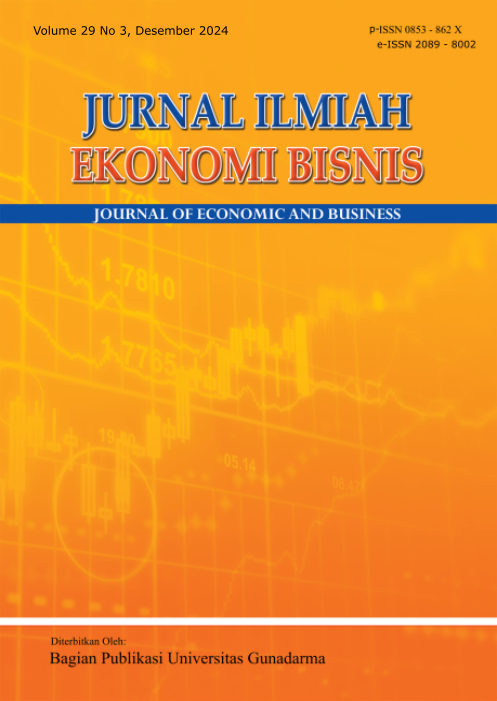MENINGKATKAN PURCHASE INTENTION MELALUI BRAND EQUITY DENGAN STRATEGI CO-BRANDING DAN SOCIAL MEDIA MARKETING PADA BRAND FASHION INDONESIA
Universitas Negeri Malang
Indonesia
Universitas Negeri Malang
Indonesia
Abstract
Local fashion products have gained the trust of the Indonesian people through the LocalPride campaign with a survey of 40.2%. Brand The aim of this research is to determine the influence of co-branding and social media marketing strategies on purchase intentions through brand equity. The difference between this study compared to previous studies is the addition of social media marketing variables and considering mediating variables which act as a link in influencing purchase intention. The type of research used was descriptive research and explanatory research with a sample of 260 Instagram followers from the local brand. The analysis technique used is descriptive statistics and PLS analysis. The results show that co-branding and social media marketing (SMM) have a direct and significant influence on purchase intention and brand equity. It was also found that brand equity has a direct influence on purchase intention. Co-branding has an indirect, positive and significant effect on purchase intention through brand equity, but social media marketing does not have an indirect effect on purchase intention through brand equity.
Keywords
References
Aaker A, D. (2018). Manajemen Ekuitas Merek. Mitra Utama.
Aqeel, Z., Hanif, M. I., & Malik, M. S. (2017). Impact of co-branding and brand personality on brand equity: A study of telecom sector in Pakistan. Journal of Business and Retail Management Research, 12(1), 86–93. https://doi.org/10.24052/jbrmr/v12is01/iocabpobeasotsip
As’ad, H. A.-R., & Alhadid, A. Y. (2014). The Impact of Social Media Marketing on Brand Equity: An Empirical Study on Mobile Service Providers in Jordan. Corrent Journal of Applied Sciences and Technology, 3(Corrent Journal of Applied Sciences and Technology, ISSN;-24571024, 09), 334–345.
Bansal, R., Zehra Masood, R., & Dadhich, V. (2014). Social Media Marketing-A Tool of Innovative Marketing. An International Journal HATAM Publishers J. Org. Management, 3(1), 1–07.
Bouten, L. M., Snelders, D., & Hultink, E. J. (2011). The impact of fit measures on the consumer evaluation of new co-branded products. Journal of Product Innovation Management, 28(4), 455–469. https://doi.org/10.1111/j.1540-5885.2011.00819.x
Cetin, H., & Kalaycı, S. (2012). The Impact of China’s Economic Growth and External Debt on China’s Foreign Direct Investment (1982-2010). International Proceedings of Economics Development and Research, 52(1), 48–52. https://doi.org/10.7763/IPEDR
Cha, M. K., Yi, Y., & Bagozzi, R. P. (2015). Effects of Customer Participation in Corporate Social Responsibility (CSR) Programs on the CSR-Brand Fit and Brand Loyalty. Cornell Hospitality Quarterly, 57(3), 235–249. https://doi.org/10.1177/1938965515620679
Chien, S., Yu, C., Wang, Y., & Kuo, P.-L. (2014). Improving the Perceived Quality of Private Brands Using Co- Branding : the Role of Brand Equity and Store Image. International Journal of Management and Sustainability, 3(9), 540–551.
Cokro, J. A. G. K. (2023). Pengaruh Social Media Marketing Brand Apparel Lokal di Instaragm Terhadap Purchase Intention Generasi Z dengan Customer Trust dan Perceived Value Sebagai Mediasi (Vol. 12, Issue 3, pp. 2621–0444). https://journal.unigres.ac.id/index.php/GemaEkonomi/index
Darwin, M., Mamondol, M. R., & Sorimin, S. A. (2021). Metode Penelitian Pendekatan Kuantitatif Kualitatif (Issue June). Media Sains Indonesia.
Dewi, Herlina, M. G., & Boetar, A. E. M. B. (2022). The effect of social media marketing on purchase intention in fashion industry. International Journal of Data and Network Science, 6(2), 355–362. https://doi.org/10.5267/j.ijdns.2022.1.002
Ebrahim, R. S. (2020). The Role of Trust in Understanding the Impact of Social Media Marketing on Brand Equity and Brand Loyalty. Journal of Relationship Marketing, 19(4), 287–308. https://doi.org/10.1080/15332667.2019.1705742
Fakhravar, H., & Tahami, H. (2022). International Co-Branding and Firms Finance Performance. International Journal of Consumer Studies, 1–28. https://arxiv.org/abs/2202.07128%0Ahttps://arxiv.org/pdf/2202.07128
Farquhar, P. H., Farquhar, A., Fazio, R., Herr, P., & Pratkanis, A. (1989). Marketing Research : Managing Brand Equity. Marketing Research, 1(1), 24–33.
Ferdinand, A. (2020). Metode Penelitian Manajemen (5th ed.). Badan Penerbit Universitas Diponegoro.
Gautam, V., & Sharma, V. (2017). The Mediating Role of Customer Relationship on the Social Media Marketing and Purchase Intention Relationship with Special Reference to Luxury Fashion Brands. Journal of Promotion Management, 23(6), 872–888. https://doi.org/10.1080/10496491.2017.1323262
Ghozali, I., & Latan, H. (2014). Partial Least Squares: Konsep, Teknik, Dan Aplikasi Menggunakan Program SmartPLS 3.0. Universitas Diponegoro.
Guha, S., Mandal, A., & Kujur, F. (2021). The social media marketing strategies and its implementation in promoting handicrafts products: a study with special reference to Eastern India. Journal of Research in Marketing and Entrepreneurship, 23(2), 339–364. https://doi.org/10.1108/JRME-07-2020-0097
Hair, J. F., Black, W. C., Babin, B. J., & Anderson, R. E. (2014). Multivariate Data Analysis (Seventh Ed, Vol. 1, Issue 2). Pearson Education.
Haitao, N. (2022). The Role of Brand Image and Product Quality on Purchase Intention (Study Literature Review). Dinasti International Journal of Management Science, 4(1), 166–174. https://doi.org/10.31933/dijms.v4i1.1466
Hasan, S., Qayyum, A., & Zia, M. H. (2022). Social media marketing and brand authenticity : the role of value co-creation. https://doi.org/10.1108/MRR-07-2021-0552
Huang, Z., Zhu, Y., Hao, A., & Deng, J. (2023). How social presence influences consumer purchase intention in live video commerce: the mediating role of immersive experience and the moderating role of positive emotions. Journal of Research in Interactive Marketing, 17(4), 493–509. https://doi.org/10.1108/JRIM-01-2022-0009
Imamah, L. F., & Hidayat, R. (2021). Pengaruh Co-Branding Terhadap Purchase Intention Melalui Brand Equity Pada Produk Indomie Hype Abis Chitato. ILMU MANAJEMEN, 95–107. http://manajemen.fe.um.ac.id/wp-content/uploads/2020/09/Prosiding-Seminar-Nasional-Ilmu-Manajemen-2020-CETAK.pdf#page=106
Jalilvand, M. R., Samiei, N., & Mahdavinia, S. H. (2022). The Effect of Brand Equity Components on Purchase Intention: An Application of Aaker’s Model in the Automobile Industry. International Journal of Data and Network Science, 6(3), 837–848. https://doi.org/10.5267/j.ijdns.2022.2.012
Jin, B., & Kang, J. H. (2011). Purchase intention of Chinese consumers toward a US apparel brand: A test of a composite behavior intention model. Journal of Consumer Marketing, 28(3), 187–199. https://doi.org/10.1108/07363761111127617
Kania, R., Sukoyo, K. S., & Wibisono, N. (2021). Effect of Co-branding Strategy Elements on Consumer Attitude and Purchase Intention : A Study in Indonesia. Journal of Marketing Innovation (JMI), 1(01), 30–50. https://doi.org/10.35313/jmi.v1i01.17
Kotler, P., & Armstrong, G. (2012). Principles of Marketing. In Pearson Education Limited (14th Editi, Issue 19). https://doi.org/10.2307/2548367
Lavorata, L., & Ruiz-Molina, M. E. (2018). Retailers’ Commitment to Sustainable Development and Store Brand Equity: A Comparison between Consumers in France and Spain. Food Retailing and Sustainable Development: European Perspectives, 131–153. https://doi.org/10.1108/978-1-78714-553-520181009
Majeed, M., Owusu-Ansah, M., & Ashmond, A. A. (2021). The influence of social media on purchase intention: The mediating role of brand equity. Cogent Business and Management, 8(1). https://doi.org/10.1080/23311975.2021.1944008
Minivaleeva, A. (2015). “Towards a Theory of Brand Equity: Measurement, Effectiveness and Managerial Implications.” In Management Science and Marketing Analytics.
Rienetta, F., Hati, S. R. H., & Gayatri, G. (2017). The effect of social media marketing on luxury brand customer equity among young adults. International Journal of Economics and Management, 11(2), 409–425. https://www.scopus.com/record/display.uri?eid=2-s2.0-85050862288&origin=inward&txGid=5180efb25dbef93323354ea3a497d592
Smith, D. J., Gradojevic, N., & Irwin, W. S. (2007). An Analysis Of Brand Equity Determinants : Journal of Business & Economics Research, 5(11), 103–116.
Sordon, A. (2021). Co-branding between Food and Luxury Fashion Brands: how it influences consumers’ purchase intention and its impact on Brand Equity and Brand Personality of the Primary Brand. Industry and Higher Education, 3(1), 1689–1699. http://journal.unilak.ac.id/index.php/JIEB/article/view/3845%0Ahttp://dspace.uc.ac.id/handle/123456789/1288
Ueltschy, L. C., & Green, B. (2002). Co-Branding Internationally: Everyone Wins? Journal of Applied Business Research, 20(3), 91–102. https://core.ac.uk/download/pdf/268103992.pdf
Utami, H. M., & Sugiat, M. A. (2023). Pengaruh Social Media Marketing Activities terhadap Purchase Intention Dengan Brand Image , Brand Awareness , Brand Equity Sebagai Variabel Intervening Pada Produk Skincare Avoskin. SEIKO : Journal of Management & Business, 6(1), 6–11. https://doi.org/10.37531/sejaman.v6i1.3743
Vidyanata, D., Sunaryo, S., & Hadiwidjojo, D. (2018). the Role of Brand Attitude and Brand Credibility As a Mediator of the Celebrity Endorsement Strategy To Generate Purchase Intention. Jurnal Aplikasi Manajemen, 16(3), 402–411. https://doi.org/10.21776/ub.jam.2018.016.03.04
Wang, S., Chan, A., & Fordian, D. (2022). the Effect of Co-Branding on Customer-Based Brand Equity of Indomie Hypeabis Campaign (Study on Collaboration of Indomie and the Goods Dept). Jurnal Pemikiran Dan Penelitian Administrasi Bisnis Dan Kewirausahaan, 121(2), 121–132. https://doi.org/10.24198/adbispreneur.v7i2.35613,
Wangpo, K., & Wangmo, S. (2022). The influence of social media marketing on purchase intention: The mediating role of brand equity. Asian Journal of Research in Marketing, 11(5), 20–33. https://doi.org/10.5958/2277-6621.2022.00018.4
Warraich, U. A., Awais, M., Amin, A., Parkash, R., & Ahmed, B. (2014). Effect of Co-Branding on Brand Equity. International Proceedings of Economics Development and Research, 69(1).
Washburn, J. H., Till, B. D., & Priluck, R. (2000). Co-branding: Brand equity and trial effects. Journal of Consumer Marketing, 17(7), 591–602. https://doi.org/10.1108/07363760010357796
Wu, D. G., & Chalip, L. (2014). Effects of co-branding on consumers’ purchase intention and evaluation of apparel attributes. Journal of Global Scholars of Marketing Science: Bridging Asia and the World, 24(1), 1–20. https://doi.org/10.1080/21639159.2013.852910
Yadav, M., & Rahman, Z. (2018). The influence of social media marketing activities on customer loyalty: A study of e-commerce industry. Benchmarking: An International Journal, 25(9), 3882–3905. https://doi.org/10.1108/BIJ-05-2017-0092
Yu, H. Y., Robinson, G. M., & Lee, D. H. (2021). To partner or not? A study of co-branding partnership and consumers’ perceptions of symbolism and functionality toward co-branded sport products. International Journal of Sports Marketing and Sponsorship, 22(4), 677–698. https://doi.org/10.1108/IJSMS-02-2020-0018


